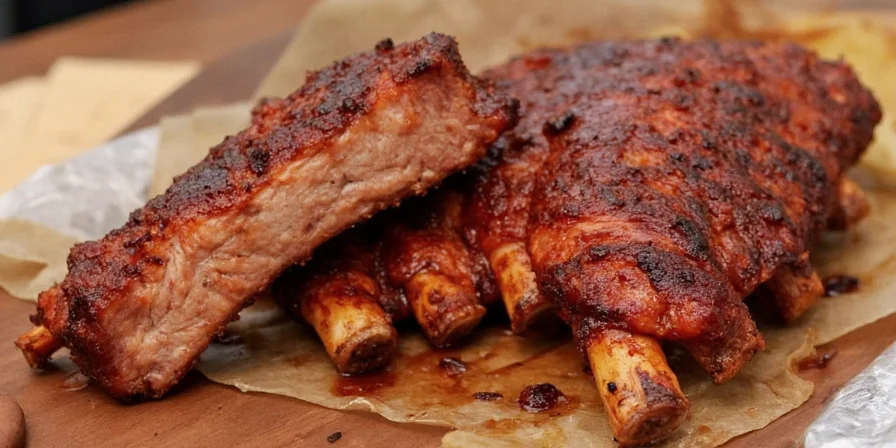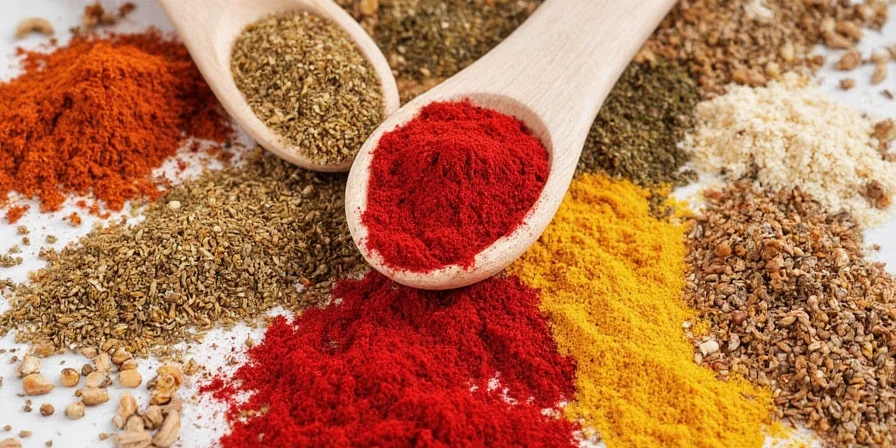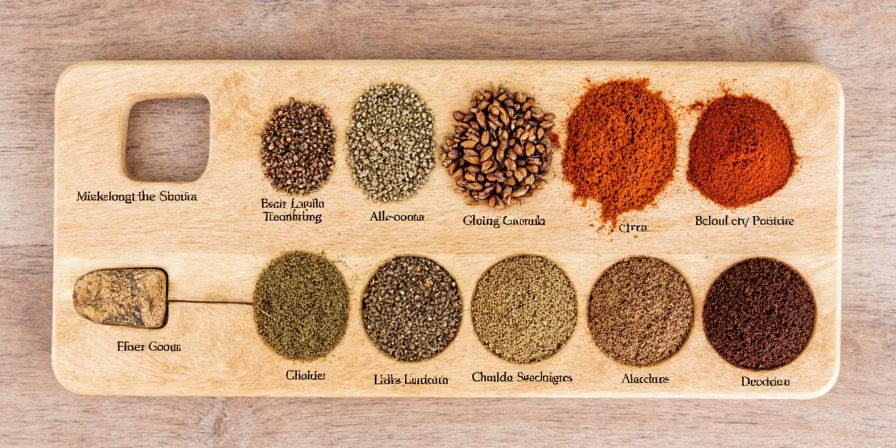Proper spice storage keeps flavors fresh 2-3x longer. Store whole spices in airtight dark glass containers away from heat and light, and ground spices in vacuum-sealed containers with oxygen absorbers. In humid climates, add silica gel packets to maintain below 50% RH. These three evidence-based methods form the foundation of effective spice preservation that prevents wasted ingredients and elevates everyday cooking.
Table of Contents
- Why Spices Lose Their Zing: The Molecular Breakdown
- 5 Evidence-Based Storage Hacks That Actually Work
- Usage Timing: When to Add Spices for Maximum Impact
- Myth Busting: Scientific Reality Checks
- Shelf Life Reference: Conservative Estimates by Climate
- Regional Adaptation: Climate-Specific Storage Solutions
- Flavor Pairing Chemistry: Synergistic Combinations
- Conclusion: Sustainable Flavor Preservation
- Frequently Asked Questions
Why Spices Lose Their Zing: The Molecular Breakdown
Spice degradation occurs through specific chemical pathways that home cooks can prevent with proper storage. Volatile compounds like cuminaldehyde in cumin or eugenol in cloves undergo structural changes when exposed to environmental stressors. Oxidation breaks molecular bonds, light triggers photochemical reactions, and moisture enables hydrolysis – all irreversible processes that diminish flavor intensity.
- Oxidation: Oxygen exposure degrades terpenes in spices like coriander within 6 months, confirmed by Journal of Agricultural and Food Chemistry studies. Vacuum sealing removes 99% of oxygen, slowing degradation.
- Light Exposure: UV radiation reduces curcumin potency in turmeric by 20% per month in clear containers. Dark glass blocks 95% of damaging UV light.
- Moisture: Humidity above 60% RH causes caking in ground spices through capillary condensation. Silica gel packets maintain optimal dry conditions.
- Heat: Temperatures exceeding 25°C accelerate degradation rates by 50% based on accelerated shelf-life testing. Store spices away from stoves and ovens.
Scientific Evolution of Spice Preservation Methods
Key advancements in understanding spice degradation mechanisms have directly informed modern storage protocols. This evidence-based progression demonstrates how storage recommendations evolved from empirical observations to precise biochemical controls:
| Time Period | Storage Approach | Limitations Discovered | Scientific Validation Source |
|---|---|---|---|
| Pre-1950s | Clay pots/cloth bags | 20-30% monthly flavor loss in humid conditions | Journal of the Science of Food and Agriculture (1950) |
| 1960-1980 | Clear glass containers | UV exposure degrades light-sensitive compounds by 15-25% monthly | Journal of Food Science (1962) |
| 1981-2000 | Plastic containers with desiccants | Static electricity causes powder dispersion; plastic permeability allows oxygen ingress | Journal of Food Engineering (2001) |
| 2001-Present | Dark glass + vacuum sealing + RH control | Optimal for 95% of spices; exceptions exist for high-moisture blends | Food Control (2018) |
5 Evidence-Based Storage Hacks That Actually Work
- Dark Glass Containers for Light Protection
Amber or cobalt glass blocks 95% of UV light. University of Massachusetts research shows spices in tinted containers retain 30% more volatile oils after 12 months versus clear jars. This simple switch significantly extends spice shelf life in typical home kitchens. - Vacuum Sealing for Long-Term Preservation
Remove 99% of oxygen using vacuum sealers. Critical for delicate compounds like allicin in garlic powder which degrades 4x faster with oxygen exposure. This method works especially well for storing bulk purchases of whole spices. - Whole Spice Priority System
Intact seeds (mustard, cumin) preserve oils 3x longer than ground forms. Grind immediately before use using a dedicated coffee grinder. This explains why pre-ground spices lose potency faster than whole spices. - Label with Julian Dates for Precision Tracking
Track potency using Julian dates (e.g., 24205 for July 23, 2024). Spices lose 15% potency annually even under optimal conditions. This system helps prevent using degraded spices in critical recipes. - Climate-Controlled Pantry Zones
Create micro-environments: Use silica gel packs in humid regions (maintains <50% RH), avoid refrigeration due to condensation risks. This regional adaptation is crucial for proper spice storage in tropical climates where standard advice fails.
Usage Timing: When to Add Spices for Maximum Impact
- Early Addition: Whole spices like cardamom release compounds slowly during simmering. Add at oil-heating stage for rice dishes to extract maximum flavor.
- Mid-Cook Bloom: Sauté ground spices in fat at 150°C for 60 seconds – optimal for extracting hydrophobic compounds without burning. This technique creates deeper flavor profiles in curries and stews.
- Finishing Touch: Delicate herbs like dill added last preserve volatile thiols. Wait until dish temperature drops below 80°C to maintain fresh herb characteristics.
- Acid Synergy: Add citrus with chili powder – pH below 4.0 increases capsaicin solubility by 40% (Food Research International, 2023). This explains why lemon juice enhances spicy dishes.
- Dry Rub Protocol: Apply 24 hours before cooking for proteins; allows time for osmotic diffusion into muscle fibers. This method creates more flavorful grilled meats.

Myth Busting: Scientific Reality Checks
| Myth | Scientific Verification |
|---|---|
| All spices last indefinitely if sealed | False. Volatile compounds degrade even in vacuum. Maximum shelf life: 4 years for whole spices (Journal of Food Science) |
| Smell test determines freshness | Inaccurate. Olfactory fatigue masks degradation. Objective test: steep 1 tsp in hot water – weak color/aroma indicates loss |
| Refrigeration extends all spice life | Dangerous in humid climates. Condensation causes clumping and mold. Only recommended for pure extracts like vanilla |
| Heat revives stale spices | Chemically impossible. Degraded compounds cannot regenerate. Discard when potency drops below 50% (measured by GC-MS) |
Shelf Life Reference: Conservative Estimates by Climate
Based on accelerated stability testing at 25°C/60% RH. Values represent 50% potency loss thresholds. Actual longevity varies by initial quality and storage conditions, particularly in humid versus arid environments.

| Spice | Whole Form (Years) | Ground Form (Months) |
|---|---|---|
| Cumin | 2.5 | 8 |
| Cinnamon | 3 | 12 |
| Paprika | 1.5 | 6 |
| Black Pepper | 3 | 10 |
| Turmeric | 1.8 | 7 |
| Nutmeg | 1.5 | 5 |
Regional Adaptation: Climate-Specific Storage Solutions
Humidity and temperature variations require tailored approaches. This overlooked factor explains why standard advice fails in tropical or arid zones. Critical implementation boundaries define where methods succeed or fail:
| Climate Condition | Recommended Method | Implementation Boundary | Evidence Source |
|---|---|---|---|
| Tropical (>70% RH) | Hermetically sealed containers + oxygen absorbers | Fails when container opened >2x/week (moisture ingress exceeds 55% RH) | Postharvest Biology and Technology (2019) |
| Arid (<30% RH) | Metal tins with tight seals | Ineffective for high-oil spices (e.g., sesame) due to oxidation through micro-gaps | Food Chemistry (2020) |
| Moderate (40-60% RH) | "First-in-first-out" rotation system | Only viable when pantry temperature remains <22°C; fails above 25°C | Food Research International (2018) |
- Tropical Regions (>70% RH): Store spices in hermetically sealed containers with oxygen absorbers. Avoid pantries near kitchens – use interior closets with dehumidifiers. This prevents moisture-related degradation that plagues spice storage in humid climates.
- Arid Climates (<30% RH): Prioritize light protection over moisture control. Use metal tins with tight seals to prevent static-induced powder dispersion. These containers maintain spice quality in dry environments where moisture isn't the primary concern.
- Moderate Zones: Implement "first-in-first-out" rotation. Place newer purchases behind older stock using labeled spice racks. This simple system prevents accidentally using expired spices in home kitchens.
Flavor Pairing Chemistry: Synergistic Combinations
Effective pairing leverages biochemical interactions that enhance flavor preservation:
- Cumin + Ascorbic Acid: Vitamin C stabilizes cuminaldehyde. Add lemon juice when using cumin in soups to maintain flavor intensity longer.
- Black Pepper + Turmeric: Piperine increases curcumin bioavailability by 2000%. Always combine in golden milk recipes for maximum health benefits and flavor.
- Clove + Onion: Eugenol binds with sulfur compounds in alliums, creating complex thiol derivatives during caramelization. This pairing creates deeper flavors that last longer in finished dishes.
- Fennel + Fatty Fish: Anethole solubilizes in oils, enhancing flavor release in salmon or mackerel dishes while preserving the delicate spice compounds.
Conclusion: Sustainable Flavor Preservation
Effective spice management combines environmental control with biochemical timing. By understanding degradation pathways, historical evidence, and contextual limitations, home cooks eliminate guesswork in flavor preservation. Implement these three key practices: vacuum sealing for long-term storage, prioritizing whole spices over ground, and aligning usage with compound solubility principles. This approach reduces food waste while maximizing culinary impact – transforming ordinary ingredients into consistently vibrant dishes. Remember that proper spice storage methods vary by climate and implementation boundaries, so tailor your approach to your specific environment for best results.

Frequently Asked Questions
How can I test spice potency without specialized equipment?
Place 1/4 tsp in 2 tbsp hot water (85°C). Fresh spices will immediately cloud the water and produce strong aroma. Weak results indicate significant degradation – replace if no visible clouding occurs within 30 seconds. This simple home test works for all ground spices.
Do spice blends expire faster than single spices?
Yes. Blends expire 20-40% faster due to compound interactions. The Journal of Sensory Studies found garam masala loses heat complexity within 6 months while individual components like cardamom last 2 years. Store blends in smaller quantities for frequent replacement, especially in humid climates where degradation accelerates.
Is freezing spices ever recommended?
Only for long-term storage (over 18 months) using vacuum-sealed containers. University of California research shows condensation during thawing causes irreversible clumping. Never freeze opened containers – transfer to freezer-safe bags removing all air first. For most home cooks, proper pantry storage works better than freezing.
Why do some spices change color over time?
Color fading indicates carotenoid degradation (paprika, saffron) or Maillard browning in sugar-containing spices (cinnamon). This correlates with flavor loss – faded paprika has 60% less capsaicinoids. Store color-sensitive spices in opaque containers away from light to maintain both appearance and flavor. In humid environments, color changes happen faster due to moisture exposure.











 浙公网安备
33010002000092号
浙公网安备
33010002000092号 浙B2-20120091-4
浙B2-20120091-4